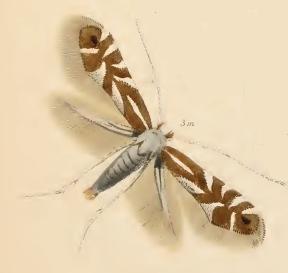
Grammodes stolida, the geometrician, is a moth of the family Erebidae. The species was first described by Johan Christian Fabricius in 1775. It is found in Africa, southern Europe, most of Asia and Australia. It migrates to central and northern Europe as far north as England, Denmark and Finland.

Phyllonorycter rajella is a moth of the family Gracillariidae. It is known from all of Europe, except the Iberian Peninsula and Greece.

Orthotelia is a genus of moths in the subfamily Orthoteliinae.Orthotelia sparganella, a moth of the family Glyphipterigidae, is its only species.
Hypatima dissidens is a species of moth in the family Gelechiidae. It was described by Edward Meyrick in 1913. It is found in Mpumalanga, South Africa.

Hypatima spathota is a moth in the family Gelechiidae. It was described by Edward Meyrick in 1913. It is found in Japan, Taiwan, India, Sri Lanka, China, Vietnam and Australia, where it has been recorded from Queensland.
Hypatima agriogramma is a moth in the family Gelechiidae. It was described by Edward Meyrick in 1926. It is found on Borneo.
Anarsia tortuosa is a moth in the family Gelechiidae. It was described by Edward Meyrick in 1913. It is found in Japan (Ryukyus) and Sri Lanka.
Ardozyga haemaspila is a species of moth in the family Gelechiidae. It was described by Oswald Bertram Lower in 1894. It is found in Australia, where it has been recorded from New South Wales and South Australia.
Stomopteryx gaesata is a moth of the family Gelechiidae. It was described by Edward Meyrick in 1913. It is found in the Taurus Mountains in Asia Minor. It has also been recorded from India.
Pyncostola invida is a moth of the family Gelechiidae. It was described by Edward Meyrick in 1911. It is found in South Africa, where it has been recorded from the Eastern Cape.
Antaeotricha thylacosaris is a species of moth of the family Depressariidae. It is found in Guyana, French Guiana and Brazil.
Antaeotricha heterosaris is a moth of the family Depressariidae. It is found in Guyana and French Guiana.
Psittacastis pictrix is a moth in the family Depressariidae. It was described by Edward Meyrick in 1921. It is found in Colombia.
Odites carcharopa is a moth in the family Depressariidae. It was described by Edward Meyrick in 1914. It is found on the Comoros in the Indian Ocean.
Hypercallia alexandra is a moth in the family Depressariidae. It was described by Edward Meyrick in 1909. It is found in Peru.
Antaeotricha protosaris is a moth in the family Depressariidae. It was described by Edward Meyrick in 1915. It is found in the Guianas and Brazil.
Antaeotricha refractrix is a moth in the family Depressariidae. It was described by Edward Meyrick in 1930. It is found in Brazil.
Imma ancistrota is a moth in the family Immidae. It was described by Edward Meyrick in 1912. It is found on New Guinea.

Ichneutica paraxysta is a moth of the family Noctuidae. It is endemic to New Zealand. This species is very similar in appearance to its close relative I. acontistis but as the range of the two species do not overlap this is unlikely to cause confusion. I. paraxysta is only found in the North Island at the subalpine zones in the Mount Taranaki region and at Mount Ruapehu. It prefers tussock grassland and shrubland habitat. The life history of this species is unknown as are the host species of its larvae however it has been hypothesised that the larval host plants are species in the genera of Poa and Festuca.

Tinea belonota is a species of moth in the family Tineidae. It is endemic to New Zealand. It is classified as not threatened by the Department of Conservation.





